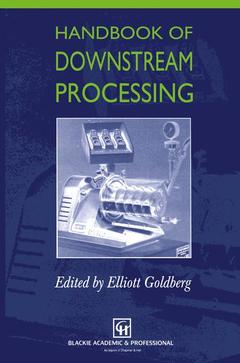Description
Handbook of Downstream Processing, 1997
Author: Goldberg E.
Language: English
Subjects for Handbook of Downstream Processing:
Publication date: 10-2011
720 p. · 15.5x23.5 cm · Paperback
720 p. · 15.5x23.5 cm · Paperback
Description
/li>Contents
/li>
The last two decades have seen a phenomenal growth of the field of genetic or biochemical engineering and have witnessed the development and ultimately marketing of a variety of products-typically through the manipulation and growth of different types of microorganisms, followed by the recovery and purification of the associated products. The engineers and biotechnologists who are involved in the full-scale process design of such facilities must be familiar with the variety of unit operations and equipment and the applicable regulatory requirements. This book describes current commercial practice and will be useful to those engineers working in this field in the design, construction and operation of pharmaceutical and biotechnology plants. It will be of help to the chemical or pharmaceutical engineer who is developing a plant design and who faces issues such as: Should the process be batch or continuous or a combination of batch and continuous? How should the optimum process design be developed? Should one employ a new revolutionary separation which could be potentially difficult to validate or use accepted technology which involves less risk? Should the process be run with ingredients formulated from water for injection, deionized water, or even filtered tap water? Should any of the separations be run in cold rooms or in glycol jacketed lines to minimize microbial growth where sterilization is not possible? Should the process equipment and lines be designed to be sterilized in-place, cleaned-in-place, or should every piece be broken down, cleaned and autoclaved after every turn?
Preface. Lysing. Filtration. Pharmaceutical applications of liquid-liquid extractions. Affinity adsorption. Membrane separations in downstream processing. Electrodialysis. Large-scale column chromatography: a GMP manufacturing perspective. Product recovery and purification via precipitation and crystallization. Lyophilization. Drying in the pharmaceutical and biotech fields. Sterilization in the pharmaceutical and biotechnology industries. Pharmaceutical packaging operations. Clean-in-place and sterilize-in-place systems. Controls and automation for biotech and pharmaceutical industries. Agitation in fermenters and bioreactors. Distillation in the pharmaceutical industry. High purity water. The facility design process. Clean room testing and certification. Regulatory considerations. Validation. Project execution for the design and construction of a biotech facility. Bulk pharmaceutical and biopharmaceutical plant design considerations. Optimization of protein recovery using computer-aided process design tools. Off-site construction: application to the pharmaceutical and biotech industries. Wastewater treatment in the pharmaceutical industry. References. Index.
© 2024 LAVOISIER S.A.S.

